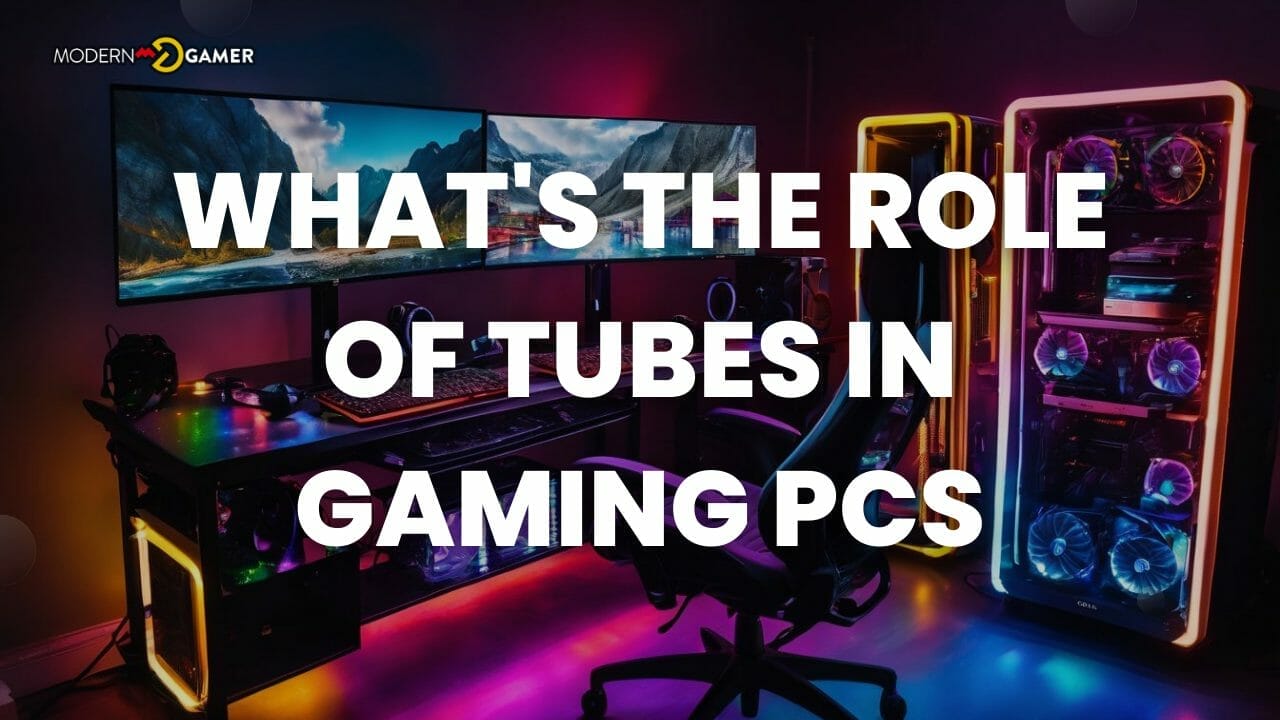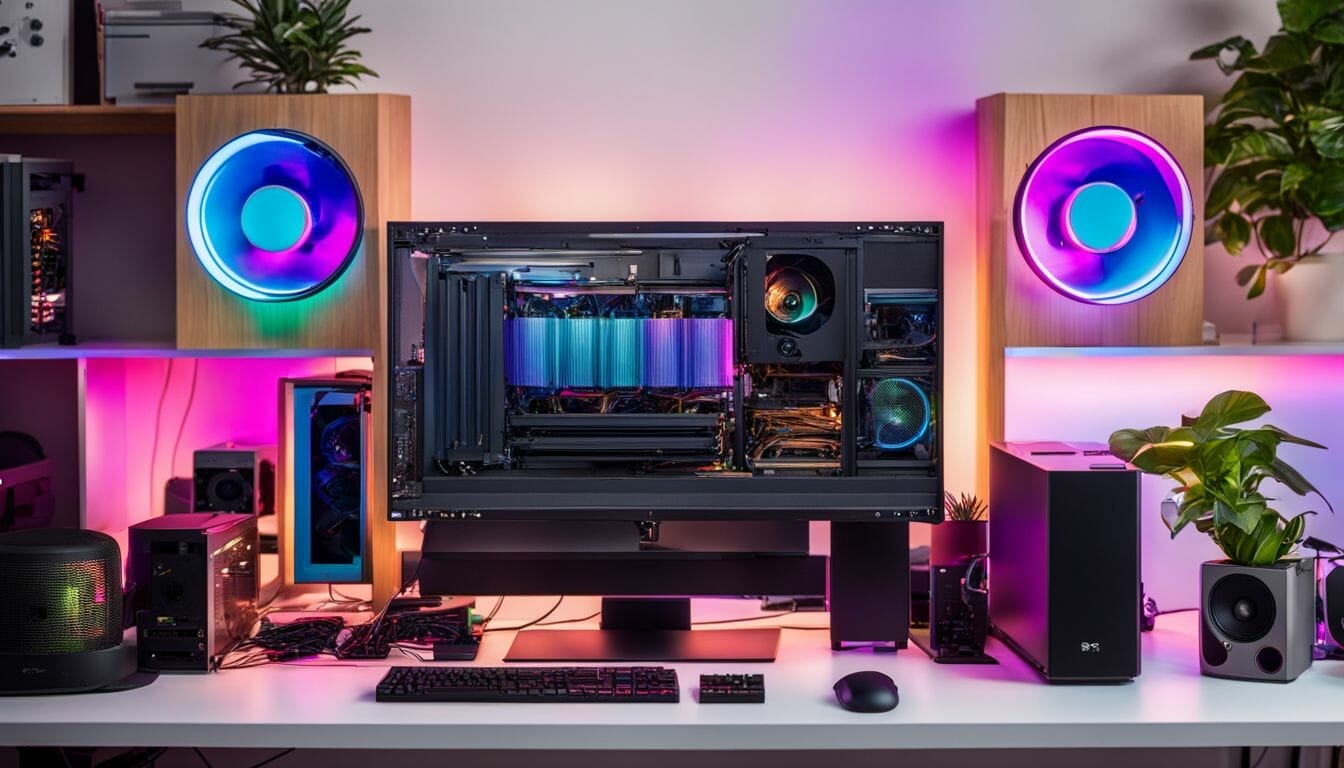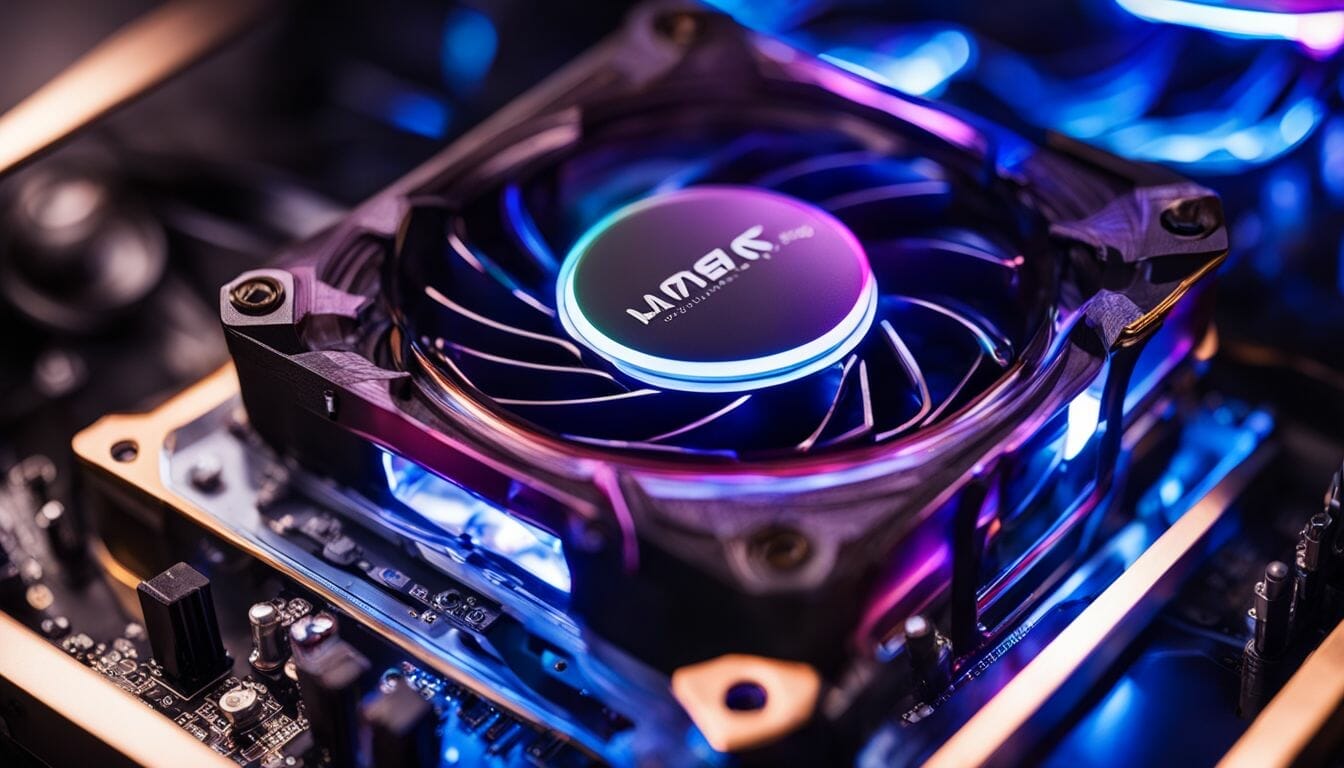Understanding the Role of Tubes in Gaming PC Cooling

Ever thought about how tubes in your gaming PC affect your gameplay? You’re not alone. At first, we didn’t give much thought to these components either. However, as we learned more, we understood their crucial importance.
In this blog, we’ll delve into the fascinating world of liquid cooling systems, specifically focusing on the crucial function of tubing. Ready to level up your knowledge about gaming PCs? Let’s dive in!
Key Takeaways
- Tubes in a gaming PC are an essential part of the liquid cooling system, helping to connect components and channel coolant throughout the system.
- They play a crucial role in ensuring efficient heat transfer by directing the flow of coolant and removing heat from critical components.
- Choosing the right type of tubing, whether it’s soft or hard, is important for proper fit and compatibility with your gaming PC setup. Regular maintenance is necessary to prevent leaks and maximize heat transfer efficiency.
Air Cooling vs. Liquid Cooling in PC Builds

Air cooling works by using fans to circulate air over the components in a PC, while liquid cooling uses tubes and coolant to transfer heat away from the components.
How air cooling works
In a gaming PC, air cooling uses fans to get rid of heat. The CPU cooler and case fans play a big part in this job. Heat leaves the parts of your PC and moves into the cool air from the fan.
The CPU cooler has metal fins that help remove hot air when they cool down. Case fans keep fresh air moving so hot air doesn’t build up. This way, we can control how warm our PCs are during game time!
Benefits and drawbacks of air cooling
Air cooling is a popular choice for many PC gamers, but like any method, it has its pros and cons. Here’s an overview in table form to clearly illustrate the benefits and drawbacks of this cooling method.
| Benefits of Air Cooling | Drawbacks of Air Cooling |
|---|---|
| Affordable: Air cooling is generally a more cost-effective cooling method compared to liquid cooling. | Noisy Operation: The fans used in an air-cooled system can produce more noise compared to a liquid-cooled system. |
| Low Maintenance: Once installed, air cooling systems require minimal maintenance. | Lower Cooling Efficiency: compared to liquid cooling, air cooling may not offer as efficient cooling performance and can result in higher temperatures. |
| Easy Installation: Air cooling systems are easier to install, making them a good option for beginners. | Size and Aesthetics: Air coolers can be larger and may not offer as sleek a look as some liquid cooling setups. |
As with anything, the best cooling method for your gaming PC depends on a variety of factors, including your budget, noise tolerance, and desired performance. It’s all about finding the balance that works for your specific needs.
How liquid cooling works
Liquid cooling moves a liquid coolant through our PC. This fluid takes in heat from the parts of the PC. It then goes to a radiator. Here, it lets go of the warmth into the air outside.
Liquid cooling is better at moving heat out of your system than air cooling. Also, they make less noise than systems that cool with air. The tubes connect the pump and water block in PCs using liquid cooling.
These tubes carry around this special fluid within our gaming machine.
Benefits and drawbacks of liquid cooling
Liquid cooling, also known as water cooling, has become increasingly popular among PC gamers due to its effective heat management capabilities. However, like any cooling method, it carries both advantages and drawbacks.
| Benefits | Drawbacks |
|---|---|
| Liquid cooling is more effective at relocating heat outside of the system compared to air cooling, which can enhance overall system performance. | Liquid cooling systems are generally more expensive and have a more complex installation process compared to air cooling systems. |
| Liquid cooling systems are typically quieter as they don’t rely on as many fans for heat dissipation. | There is a risk of coolant leakage in liquid cooling systems which can cause significant damage to the system components. |
| Radiator fans in liquid cooling systems are less bulky than CPU fans, meaning they take up less space in the PC case. | Liquid cooling systems require maintenance to ensure optimal performance and longevity, such as periodically replacing the coolant. |
While liquid cooling may initially seem daunting due to its cost and setup process, its advantages may make it a worthwhile investment for gamers seeking a quieter, more efficient cooling solution.
Components of a Liquid Cooling System

A liquid cooling system consists of various components such as cooling blocks, radiators, pumps, reservoirs, tubing, and cooling fluids. These components work together to efficiently dissipate heat from the gaming PC.
Curious to know how each component plays a role? Keep reading!
Cooling blocks
The cooling blocks are important components in a liquid cooling system for gaming PCs. These blocks contain hollow tubes and ducts filled with heat-conductive materials like copper or aluminum.
Their main job is to cool specific parts of the PC, such as the CPU or GPU. To enhance heat transfer, thermal pastes are used between the water block and these components. In custom cooling loops, each component has its own water block to ensure efficient cooling.
Compared to air cooling, using these cooling blocks can improve performance and reduce noise in your gaming PC setup.
Radiator
The radiator is an important component of a liquid cooling system in a gaming PC. It helps to dissipate heat from the processors by circulating coolant through its fins. Radiators are usually made of copper or aluminum, and their size can impact the cooling performance.
Proper mounting of the radiator is crucial for efficient liquid cooling in your PC. It’s essential to choose a good-quality radiator that fits well with your system to ensure optimal cooling for your gaming sessions.
Pump
The pump is a crucial component in a liquid cooling system for a gaming PC. Its main job is to push the liquid coolant through the system, ensuring that it circulates properly and effectively cools the components.
The flow rate of the pump determines how quickly the coolant moves through the tubes, which affects its cooling efficiency. Specialized centrifugal pumps are commonly used in PC cooling systems to minimize noise.
The pump also plays a role in allowing the coolant to absorb heat from the CPU or GPU, ensuring efficient heat dissipation.
Reservoir
The reservoir is an important part of a liquid cooling system in a gaming PC. It acts as a holding tank for the coolant, which is the substance that cools down your computer’s components.
Separate tubes are connected to the reservoir, allowing coolant to flow to and from other parts of the system. This helps maintain a steady supply of coolant for effective cooling.
Additionally, the reservoir assists in dissipating excess heat from the coolant, contributing to overall cooling efficiency. So, having a good quality reservoir ensures that your gaming PC stays cool during intense gameplay sessions.
Tubing
Tubing plays a crucial role in a gaming PC’s liquid cooling system. It connects different components, such as the water cooling block, radiator, and pump, allowing coolant to flow through the system.
The tubing also channels the coolant to ensure efficient heat transfer from the components to the radiator for dissipation. It is important to choose the right type of tubing based on preferences and needs, whether it’s soft tubing or hard tubing.
Proper sizing and installation techniques are essential to prevent leaks and maximize heat transfer efficiency. Regular maintenance is necessary to check for any signs of wear or leaks in the tubing so that problems can be addressed promptly.
Cooling fluids
Cooling fluids play a crucial role in liquid cooling systems for gaming PCs. These fluids, which can be water, specialized liquids, or mixtures, are responsible for efficiently transferring heat away from the components.
It’s important to choose the right coolant based on factors like thermal conductivity and corrosion resistance. The tubing in a liquid cooling system carries these fluids, ensuring their continuous flow and preventing any air bubbles that could affect cooling performance.
Regular inspection and maintenance of the tubes are necessary to keep the system running smoothly and ensure optimal cooling efficiency.
The Role of Tubing in a Gaming PC
Tubing plays a crucial role in a gaming PC by connecting components, channeling coolant, and ensuring efficient heat transfer.
Connecting components
To properly cool a gaming PC with liquid cooling, it’s important to connect all the components together. That’s where tubing comes in. Tubes are used to link the pump to the inlet of a water block in a liquid-cooled system.
Separate tubes then run from the water block’s outlet to other components like the CPU, GPU, and RAM cooling blocks. By connecting these parts, coolant can flow through each component efficiently, removing heat and keeping your gaming PC running at optimal temperatures.
Channeling coolant
The tubes in a gaming PC are responsible for channeling coolant throughout the system. This coolant, usually distilled water, helps to keep the components cool and prevent overheating.
As liquid cooling is more effective than air cooling, it’s important that the tubes efficiently circulate the coolant to all necessary parts. This ensures that heat is transferred away from critical components, allowing for optimal performance and reducing the risk of damage.
By directing the flow of coolant through different parts of the system, the tubing plays a vital role in maintaining efficient heat dissipation and ultimately improving overall gaming experience.
Ensuring efficient heat transfer
To ensure efficient heat transfer in a gaming PC, the tubing plays a crucial role. The tubing is responsible for connecting the components of the liquid cooling system and channeling the coolant.
This allows for effective heat dissipation and prevents overheating. The thermal conductivity of the tubing material is important as it affects the rate at which heat can be transferred.
By choosing high-quality tubing and ensuring proper installation techniques, we can optimize cooling efficiency and keep our components running at optimal temperatures. With good tubing in place, we can enjoy better performance and prevent any potential damage caused by overheating.
Tips for Choosing and Installing Tubing
Choose the right type of tubing for your liquid-cooled gaming PC, whether it’s hard or soft tubing, to ensure proper fit and compatibility with your components.
Types of tubing (hard vs. soft)
When it comes to choosing tubing for your gaming PC, there are two main types: hard tubing and soft tubing. Soft tubing is more flexible and easier to install compared to hard tubing.
It’s great for beginners or those who want an easy installation process. On the other hand, hard tubing is more difficult to shape and may require some skill to create clean-looking systems.
However, it offers durability and is less prone to collapsing or kinking. If you need tight bends inside your computer case, soft tubing is recommended. So consider your preferences and needs when selecting the right type of tubing for your gaming PC setup.
Sizing and cutting tubing
Choosing the right size of tubing is important for your gaming PC’s water cooling system. The diameter of the tubing affects how the coolant flows through the system, so it’s essential to get it right.
You’ll want to consider factors like fluid flow and friction when selecting the appropriate tube size. Additionally, cutting tubing may be necessary during installation. Be sure to use proper techniques and tools to make clean cuts without damaging the tubing or affecting its performance.
Proper installation techniques
Proper installation techniques are crucial for setting up a liquid cooling loop in your gaming PC. Here are some tips to help you ensure a successful installation:
- Selecting suitable connectors and hoses: Choose connectors and hoses that are compatible with your chosen liquid cooling system. This ensures a secure and reliable connection.
- Ensuring proper watercooling loop sequence: Follow the correct order when connecting the components of your liquid cooling system. Typically, the sequence is pump, radiator, CPU block, GPU block, and reservoir. This ensures efficient coolant flow and optimal cooling performance.
- Leak detection and testing: Before finalizing your installation, it’s important to perform leak detection tests. Check for any potential leaks by using a leak tester or performing a “leak test” where you fill the system with water without powering on the PC. This allows you to identify and fix any leaks before turning on your gaming rig.
- Employing appropriate radiator screws: When mounting the radiator in your PC case, use the correct screws provided with the radiator or recommended by the manufacturer. Using improper screws can damage the radiator or cause it to become loose.
- Optimal installation procedures: Follow manufacturer guidelines for installing components such as water blocks, pumps, radiators, reservoirs, and tubing. These guidelines provide step-by-step instructions specific to your chosen hardware.
- Choosing the right tubing and fittings: Consider factors like flexibility, compatibility, durability, and size when selecting tubing for your liquid cooling system. There are two main types of tubing: hard (rigid) tubing and soft (flexible) tubing. Choose the one that suits your needs best.
Conclusion
In conclusion, tubes play a vital role in liquid-cooled gaming PCs. They connect the pump to the water block and help circulate coolant throughout the system. The tubes form a cooling loop that helps maintain efficient heat transfer, providing better thermal performance for your gaming PC.
So, when building a liquid cooling setup for your gaming rig, don’t forget about the importance of these small but crucial components.
FAQs
1. What role do tubes play in a gaming PC?
Tubes in a gaming PC are used for liquid cooling, helping to dissipate heat from the components and keep them cool.
2. How do tubes help with cooling in a gaming PC?
The tubes carry coolant or water to different parts of the PC, such as the processor or graphics card, absorbing heat and transferring it away through radiators.
3. Are tubes necessary for all gaming PCs?
No, not all gaming PCs require liquid cooling with tubes. Air cooling systems using fans can also effectively cool the components.
4. Can I install tubes and liquid cooling myself in my gaming PC?
Installing tubes and liquid cooling requires advanced knowledge of computer hardware and proper setup techniques, so it’s best to consult a professional if you’re unsure or inexperienced.
5. What are the advantages of using tubes for liquid cooling in a gaming PC?
Liquid cooling with tubes provides more efficient heat dissipation compared to air cooling, allowing for lower temperatures during intense gameplay sessions which can extend component lifespan and potentially improve performance.

